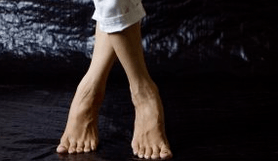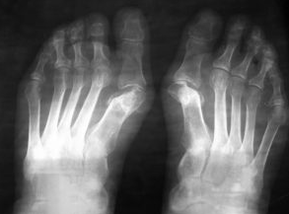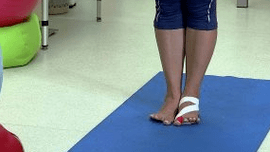Surgical treatment of valgus deformation is considered an effective method of therapy.This disease is characterized by a pathological change in the shape of the foot, which requires restoration otherwise, complications are possible up to disability.The operation is usually carried out at 3-4 stages of pathology.

Surgery as an effective treatment method Valgus
Development factors
The valgus deformation of the foot is difficult to determine in the first stages due to asymptomatic.Ballerins, women who prefer to wear high studs, people of advanced age, are located in the formation of such a pathology.Such reasons for the formation of the valgus foot are distinguished:
- diseases of the endocrine system;
- flat feet;
- violation of the ligamentous apparatus;
- limb injuries;
- heredity.
This disease is classified into such stages of development depending on the degree of lesion:
- The first finger is less than 20 degrees shifted, while the patient does not feel discomfort.
- The connection is shifted by 30 degrees.The pain manifests itself after loads.
- Displacement from 30 to 50 degrees.Pain sensations of constant nature that do not allow to move normally.
- The joint shifts more than 50 degrees.Strong deformation of the foot and acute pain.
In children, Valgus deformation can be congenital or acquired.This disease develops against the background of pathologies of the musculoskeletal system.The first signs appear when the child begins to walk.
What is Valgus dangerous?
During the development of such a pathology, a sick person is faced with the problem of selection of shoes, because the Bulging bone brings severe discomfort and pain when touching it.In addition to aesthetic modifications, Valgus deformation affects such structures on the foot as ligaments, tendons, bones and compounds.As well as Valgus, the feet are dangerous to the development of such pathologies of the musculoskeletal system:
- deforming arthrosis;
- Bursit in a chronic form;
- longitudinal-transverse flat feet;
- the growth of bone-cheerful structures;
- Complete displacement of the plus bone.
Indications for operations in Valgus foot

Non -operational treatment for valgus deformation is carried out only by the child until the foot is completely formed.The main indicators for intervention are pain, discomfort, limited motor activity, inflammatory processes, infection, strong visual changes and gait violation.The flat-valgus foot is only surgically treated.Other methods - gymnastics, orthopedic shoes, suspend the development of pathology.But at 3-4 stages in conservative ways not to solve the problem.At this stage, the finger deviates 25-35 degrees, and the plus bone sinks 18 degrees, which is deformed by the rest of the phalanges.
Types and features of providence
The selection of a certain type of operation is carried out individually depending on the degree of development of the pathology, the patient's condition and related diseases of the musculoskeletal system.More often such types of surgical intervention are used:
- Osteotomy.It is reconstructions.A small incision is made through which the lateatarsophalangeal connection is carried out.Then the elimination of the bone growth is carried out.Removing the bone is performed on Immobilized joint.Osteotomy is carried out with the subsequent consolidation of bone fragments using compression titanium device.Distinguish the following subspecies: Austin with V- or L-shaped secation, used for a display of 17 °;Scarf with Z-shaped-at 17-40 ° deviation;Akin (wedge -shaped) - combines with other methods.
- Small -invasive intervention is a sparing technique.Punches are made on both sides of the thumb.The surgeon introduces micro-tools and restores the correct position of the axis of the first finger.The action is controlled through the monitor.This type of operation is carried out by children when traditional treatment methods have not given results.
- Arthrodesis is a radical method.Deformation and pain are eliminated, but the connection becomes motionless.The lack of mobility does not affect the gait of a person.Through the open incision, parts of the head of the proximal and first plus bone are removed, the remaining fragments are connected by screws that will subsequently be removed.

Correction of the position of the bone is a complex operation.Immediately after surgical manipulations, the specialist recommends bed rest.Swelling of soft tissues is removed with cold compresses.The first 6 weeks of walking is possible only in an orthosis, which will remove an additional load from the limb.Restoring ordinary motor activity - after 1.5 months.Rehabilitation takes about six months.The postoperative period (10 days) the patient is in the hospital under the supervision of doctors.To speed up the recovery process, the operated limb is important to keep above the body in the lying position.Rehabilitation includes massage courses, electrophoresis, exercise therapy and UVT.
Complications
Surgical interventions of such a plan are mainly tolerated at any age.But there are undesirable complications.These include:
- the formation of thrombosis;
- infectious infections of the body;
- aseptic necrosis;
- restriction of the motor amplitude of the thumb;
- injuries of nerve endings;
- allergic manifestations;
- Paresthesia of the fingers.
Forecasts after surgery
If the intervention is carried out on both feet, it is important to take a break of 3-6 months.
If you follow the doctor’s recommendations, the forecasts are favorable.Do not load the operated limb with strong physical exertion.After surgery, you need to wear orthopedic shoes or special insoles.It is better for women to abandon high heels and dense shoes.Thanks to modern methods in the field of surgery, Valgus is subject to complete correction.























